Unstable Scraps, Part 2
Last week, I started telling some Unstable card-by-card design stories. As I worked on the set for over six years, I have a lot of stories to tell. So much so that I'm not done yet. But enough of me yapping, let's get to more stories.
Dr. Julius Jumblemorph
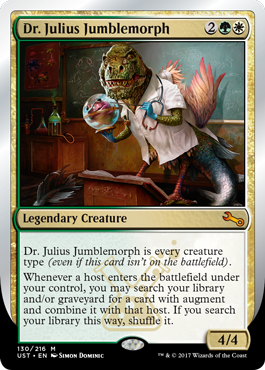
This card actually started out as a host/augment commander. One of the biggest problems with host and augment in Commander is there aren't enough cards to properly fill out a deck, and we wanted to make a creature that could help guarantee that you could get host creatures augmented. We tried a lot of things that were far subtler, but we found that it didn't accomplish the job we wanted, so eventually we moved toward a very blunt version. Play a host creature, go and get the augment card you want, and augment the host.
Then during the worldbuilding, the artist had a blast designing creatures for the Crossbreed Labs. One of the creatures they drew was basically the art on this card. We loved it so much that we decided we had to find a home for it. We knew the legendary creature was going to be the leader of the Crossbreed Labs, so it seemed like a perfect fit. The changeling-like ability (I'm actually not sure why we didn't just make it changeling—probably because, creatively, he's not a Shapeshifter) was added to capture the feel that Dr. Julius Jumblemorph was so many different creatures in his art.
Earl of Squirrel
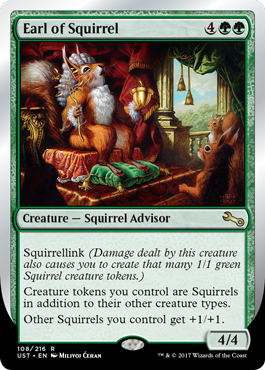
One of the things I knew going into design was that we were going to have a Squirrel lord. I was mad at myself that I'd somehow managed to make two Un- sets before and had never created a Squirrel lord. In my defense, I did make the card Deranged Hermit in Urza's Legacy that's a Squirrel lord in black border.
I knew I wanted two things. One, I wanted it to grant Squirrels +1/+1. Two, I wanted it to have a very Squirrel-y keyword ability. The first was simple, but the second one took more time. One of the things I like doing on Un-set cards is taking a known keyword and then tweaking it to make it a little stranger. Denimwalk on Hurloon Wrangler in Unglued is a good example.
One keyword I'd been playing around with was lifelink. What if I took the framework, but changed the outcome to make it something other than gaining life? For example, if every time you dealt damage, you added a mana of any color to your mana pool for each damage, that would be manalink. I tried all sorts of different versions: discardlink, milllink, shocklink, etc. Then I stumbled upon the idea of making a creature token: goblinlink, elflink, zombielink, and so on. This seemed like the right path.
One day, I was looking at Earl of Squirrel (I think the design name was Squirrel Next Door), and it dawned on me that squirrellink was exactly what I was searching for. The card would make Squirrel tokens with the first ability and then boost them with the second. Something was missing, though.
Despite my best efforts, there aren't a lot of Squirrels in Magic. Was there any way to make this card more relevant to things other than Squirrels, yet still feel like a Squirrel lord? What if the card could make other things into Squirrels? After some thought, my favorite idea was to affect token creatures, as that was something green does frequently.
The last big question was about whether or not to make this a legendary creature. Yes, it would make a good commander, but it's also the kind of card that Squirrel decks would want to have four of on the battlefield, since the bonus stacks. For regular readers of my blog, this is a topic that comes up often—the tensions of legendary having rules baggage. In the end, I'd made a lot of legendary creature in the set, so I decided to throw a bone to the Squirrel decks—as, after all, this is a Squirrel lord.
Entirely Normal Armchair
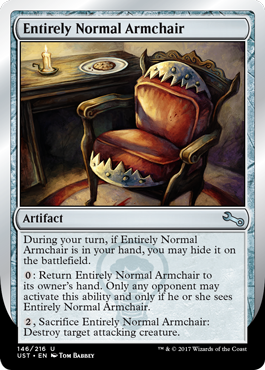
Between market research and interacting with players, I'm well aware of the big successes of previous Un- sets. Whenever possible, I made an effort to make new cards in the spirit of old successes. Entirely Normal Armchair is basically Cheatyface, the Furniture. For those unaware, Cheatyface was a creature from Unglued that you could sneak into play for free, provided your opponent didn't catch you sneaking it in. (By the way, the Oracle text for cards from both Unglued and Unhinged will be updated in Gatherer with current templating and rules text. The Oracle text for Cheatyface will soon better reflect its actual rules; you have to legally draw it before you cheat it onto the battlefield.)
Entirely Normal Armchair plays in a slightly different space (it's more defensive), but has the same gimmick of having to sneak it into play. In fact, I took away the ability for you to cast the card normally. You want to play Entirely Normal Armchair? You have to sneak it in. Playtesting this card has shown that the ability is still a lot of fun.
Extremely Slow Zombie and Three-Headed Goblin

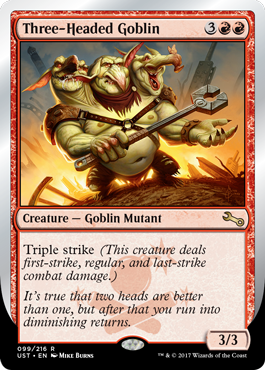
In Future Sight design, Mark Gottlieb (then rules manager) created a futureshifted card with last strike. It was the mirror opposite of first strike; you did damage during a period of time after normal damage. The design team then did what any design team would do upon seeing last strike: we made a card with triple strike. When Mark put on his rules manager hat months later, he ended up vetoing the idea, as it required an extensive rewiring of how damage worked.
I liked the idea, so I put it on my "Save for the next Un- set" list. Extremely Slow Zombie and Three-Head-Goblin were two of the earliest cards put into the design file, and basically went unchanged through all of design and development.
GO TO JAIL
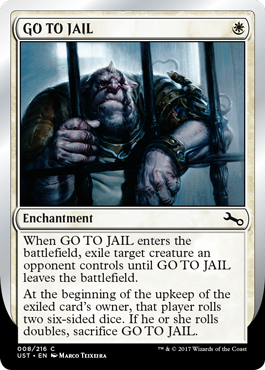
The idea for this card came about when we were experimenting with what we could do with six-sided dice. As a brainstorming exercise, we thought about what other games did with them. It took a while, but we eventually ended up thinking of Monopoly and the "go to jail" mechanic (roll each turn until you get doubles). It then dawned on us that perhaps we could not only mimic the ability—perhaps we could actually reference it. Wizards of the Coast is owned by Hasbro, who makes Monopoly, so we asked our brand team to reach out and ask the Monopoly people if we could do it. They said yes, and now we have our first ever official call-out to another game in a booster product. (Note that there's another call-out in Unstable to Dungeons & Dragons on the card Sword of Dungeons & Dragons.)
The Grand Calcutron

This is another example of a card that got created by combining two different designs in the file. The first card was a legendary artifact that represented the leader of the Order of the Widget, who had upgraded himself so much that he'd become a machine. The second card was an enchantment created mechanically to represent the idea of turning your hands into programs. We tried a whole bunch of different designs for the leader, but nothing quite captured the computer-like quality we were going for. Then one day it dawned on us that the program card could be turned into an artifact and just be the leader.
Everything worked out wonderfully except for one thing. It was always our intention that the legendary artifact that led the Order of the Widget was going to be legal as a commander, but because it wasn't a creature, we had to add that text to the text box. The problem was, by the time we wrote out all the text for the "programming" part of the card, there wasn't any room left, so the Commander rider text had to be left off. We talked about making him a creature, but the whole point of the card was that he evolved to not be human any more, so making him a creature would have undercut the whole flavor.
Grusilda, Monster Masher

Grusilda is the third of four members of the cabal that runs the League of Dastardly Doom. After some initial tinkering, she ended up as a sort of Dr. Frankenstein/Dr. Moreau–type character who messes with biology, grafting dead creatures together. Kelly Digges ended up making her a Zombie, as the idea of an undead creature that messes around with undead creatures was cool.
Her original version didn't interact with host and augment, but we realized that thematically what she was doing was so similar that it seemed wrong not to make the mechanical connection. Also, she originally combined abilities, but once we started messing around with stealing text boxes on some other cards, we decided she could just give the combined creatures both text boxes.
Handy Dandy Clone Machine
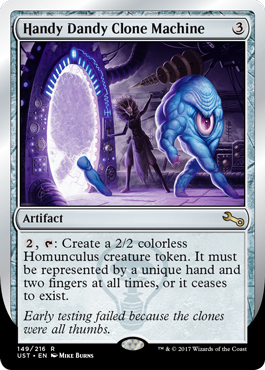
One of the elements that Un- sets like to play with is utilizing mechanics where physicality matters. That's just something normal black-border Magic doesn't do, and it can add a layer of fun to the gameplay.
Also, I was interested in retrying something I had tried in Unhinged on a card called Shoe Tree.
Shoe Tree required you to use shoes to represent counters. The idea was that people only had two shoes, so it limited playing more than one of the creature (as each required two counters). If you had a second one, you'd have to get shoes from somewhere else, most likely another person. Players got around this, though, by bringing extra shoes. Was there a way to capture this but in a less breakable way?
Also, we were playing around with the outside assistance theme, so my mind was in a space of getting other people involved in your game. I ended up focused on hands. What if a card required the use of a hand? There was no way to bring other hands (seriously—the rules require the hands be attached to living people), so this would force interaction with other humans. The big question was, what to do with the hands?
I thought about what hands could do and ended up realizing that they could make a little walking creature (see the art of the card if you're confused about what I mean). Those would be fun tokens. Also, the limitation would allow us to lower the cost. How many tokens can you make when each one must be a new hand? Yes, you get two you can do (and even then it starts creating some physical limitations for you), but beyond that you had to get help. My best so far was ten tokens when I got four other people to help me by being tokens. If you all do better than that, take a picture and send it to me.
Hangman
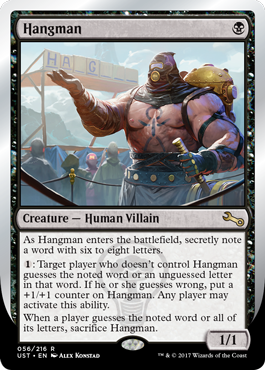
This card started with a simple premise. It's a card called Hangman that forces your opponent to play Hangman. The big question was, what exactly does that mean? We wanted to call it Hangman, so it needed to be a creature. We also wanted to force your opponent to play Hangman, so that meant there had to be a reward for your opponent getting the word, and there had to be a reward for you until they did.
The most obvious reward for your opponent was to kill the creature. That meant that the reward for you wanted to be the creature getting better. A +1/+1 counter seemed the easiest way to do this. Okay, your opponent tries to guess your word, and the creature keeps getting bigger until they do, at which point the creature dies.
The next question was, when does the guessing happen? We tried it as an upkeep effect, but it just took too long to guess the word. What if we found a trigger that happened more frequently? We toyed with it happening whenever a spell was cast, but it tended to mess with the flow of the game. The solution, we realized, was an activation that either player could use. Early in the game, you'll activate it to make your creature bigger. Then later in the game, your opponent will start activating it because they'll be motivated to get rid of what is probably a decently large Hangman.
Hot Fix
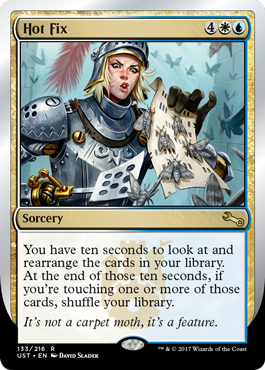
One of the early mechanics we played with was called stopwatch. The card instructed you to do something while your opponent timed you. You had to do the required task in the set amount of time, at which point you got a bonus or some negative thing would happen if you couldn't do it. We ended up finding a few cool effects, but the mechanic required a lot of things all clicking together to work. In the end, we couldn't make enough designs to justify doing the mechanic.
Hot Fix is the stopwatch design we liked the most. Rearranging your library was a cool task with many different possible uses, and the negative of shuffling was a thematic and mechanically relevant drawback. It was a clean way to say, "No, really, you only get 10 seconds." For those wondering, we did try this at numerous different time amounts and found 10 seconds to be the sweet spot.
Hydradoodle

When the sketch by Mathias Kollros came in for the card Domesticated Hydra in Conspiracy: Take the Crown, it looked a lot like the art for Hydradoodle. The art team thought it was a little silly for the tone the set wanted, so they asked the artist to try a different approach.
Fast-forward to Unstable art commissioning. Dawn Murin, the set's art director, was given a Hydra to get illustrated. She knew exactly what she wanted. She called up Mathias Kollros and said, "Remember the original sketch you did for Domesticated Hydra? We want that."
For those who know their Un-set history, Infernal Spawn of Evil from Unglued has a similar story, where artist Ron Spencer turned in a piece as a joke and we later came back and asked him to use the illustration for a card.
Infinity Elemental
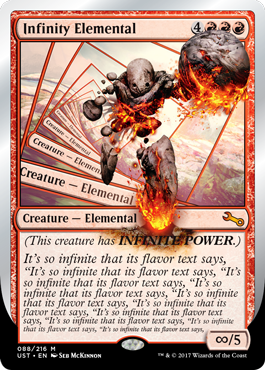
Sometimes on social media I like to make little throwaway comments about things I did that day that I thought were quirky. Usually the comments are pretty vague, as the intent is not to give away any details, just pique players' interest. Infinity Elemental is an example of a comment that got a little away from me.
The day the card was put into the file, I commented (on Twitter I think, but maybe my blog), "I put a vanilla creature into mythic rare today." (Vanilla is R&D slang for a creature with no rules text.) The thing I knew that the audience didn't was that I was working on an Un- set. This was probably three years before we even announced the set's existence to the world. I knew in a vacuum that a mythic rare vanilla creature would sound like a weird claim.
I assumed the audience would go "hmm" and go on with their day. That's not what happened. People were very interested in the news. Some were excited by it. Others were angry. Others were perplexed. All of them, though, wanted to talk about it. People debated what it could mean and spent a lot of time coming up with theories on how it could be done.
Even once it died down, every few months I'd be asked if the card was still in the file. I'd say yes, and talk would peak once again. I started worrying. Unstable wasn't public and I didn't want people figuring out we had a set sitting around for years, so I started being coy about whether the set I first talked about was the same set it was currently in. Eventually we announced the existence of Unstable, and that day I let everyone know that the vanilla mythic rare was in it. This increased the talk, with people asking more and more questions about it.
So, one of the many reasons I'm excited Unstable is out is so I can stop answering questions about it and just let you all play with it.
Just Desserts
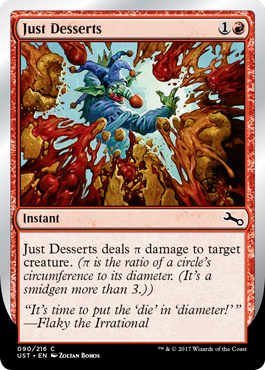
This card existed before Unstable was a twinkle in my eye. Whenever I get a fun idea for an Un- card, I always write it down and keep it in a file I have for unpublished Un- cards (what I call the Un-Published). I don't even remember what inspired me to create this card. What I do remember is how tickled I was by it. It was wordplay that functioned mostly like a normal card, but with just enough weirdness to be at home in an Un- set. Just Desserts, called Clown Attack in design, was the first card in Unstable.
It was always my intent for the card to show a clown throwing a pie. As I mentioned last week with The Big Idea, for a while the set had some Clown Minions it, and I assumed one of them would be throwing the pie. When they went away, I begged Kelly to please let this card have a clown throwing the pie. Kelly said okay and ended up making it a Goblin clown, the only clown pictured in the whole set.
One last story: My original pitch for how to announce Unstable to the world was to just post Just Desserts on my social media on Pi Day (March 14—the first three digits of pi) and let the public figure out that this one card meant a new Un- set was coming. It ended up being a little too early, and Just Desserts is a little off-center from what the set's about (you want early previews to give a good taste of what the set is), so that plan never happened.
Kindslaver
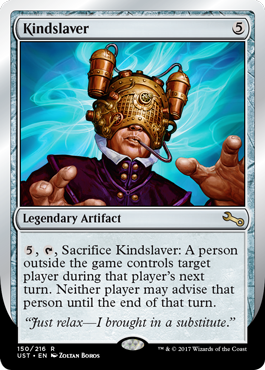
One of my favorite stories about Unstable play design comes from Kindslaver, called Friendslaver in design.
It's late in development and Ben Hayes is leading the development team. He's doing a playtest, playing against another member of the development team, I think Mark Purvis. Mark is about to win on his next turn, so Ben casts Kindslaver and activates it.
Ben looks around and sees Tim Aten, one of the Magic editors at the time. Tim's busy at work editing a set, but there's not a lot of other people around, so Ben decides to ask Tim if he could help him. Tim looks up and Ben gestures for him to come around to the table where the game is at. Tim gets up and walks around to the table. Ben explains that he needs Tim to take control of Mark for the turn. Tim sits down, studies the board, and then proceeds to kill Ben.
Ben is shocked and asks, "Why'd you do that?" Tim replies, "To teach you that next time you need someone to do this, get someone else." Ben starts laughing hysterically as Tim walks back to his desk.
Unstable Service
Once again, I am out of time yet not out of stories. As always, I'm interested in any feedback both on Unstable and on this column. You can write to me through email or contact me through any of my social media accounts (Twitter, Tumblr, Google+, and Instagram) to give me feedback.
Join me next week for my final card-by-card stories on Unstable, my last new article of 2017.
Until then, be careful who you ask to help you when you Kindslaver.
#492: Printing
#492: Printing
32:14
I talk a lot about the process of creating what the cards do, but part of making Magic cards is also physically creating them. In this podcast, I talk about how we print Magic cards and what impact that has on designing them.
#493: 20 Lessons: Challenging Players
#493: 20 Lessons: Challenging Players
30:36
This is the sixteenth installment in my "20 Lessons, 20 Podcasts" series where I talk about each of my lessons from my 2016 Game Developers Conference talk. In this podcast, I talk about the lesson "Be more afraid of boring your players than...
- Episode 491 Being Spokesperson (21.8 MB)
- Episode 490 Unstable, Part 3 (28.3 MB)
- Episode 489 Unstable, Part 2 (28.1 MB)

